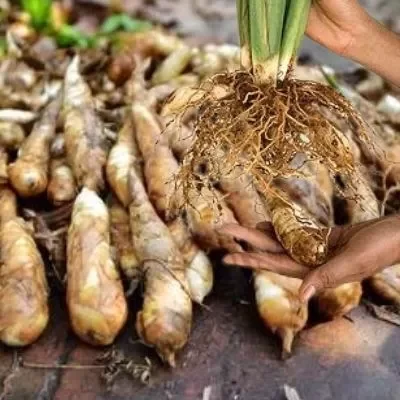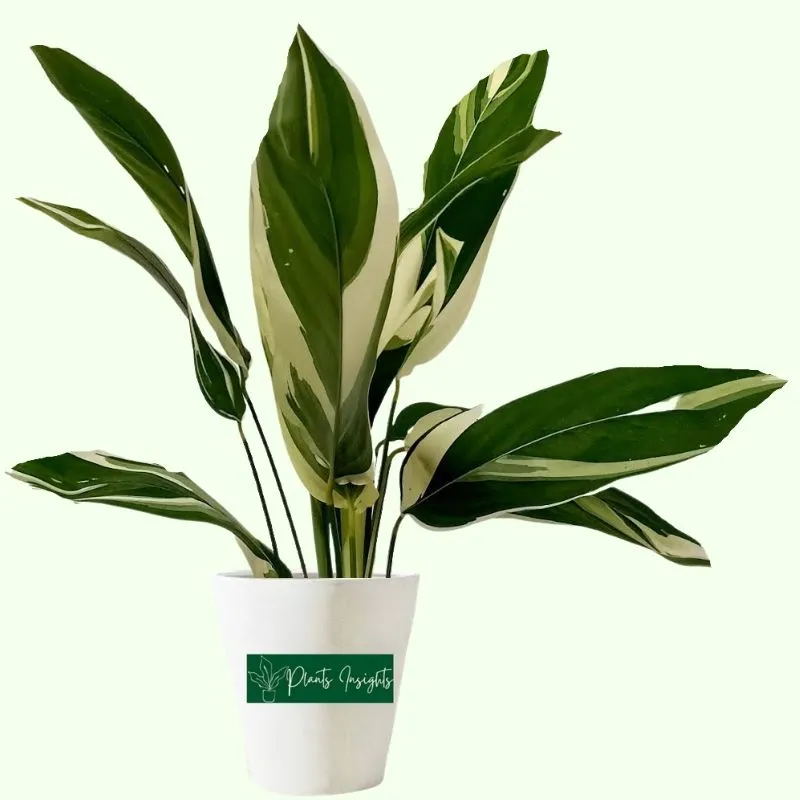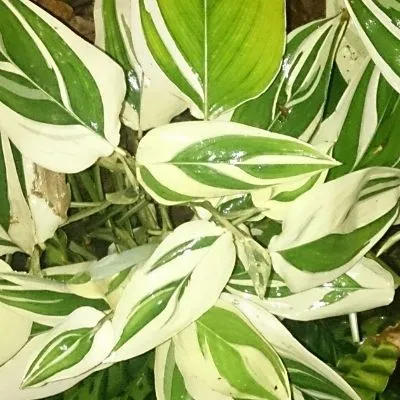Another gorgeous variant of the Arrowroot plant known as Maranta Arundinacea Variegata is famous for its artistic-looking foliage and the commercial use of its roots. Maranta Variegata develops the classy look of the indoor corner, displaying the oval-shaped leaves with pointed edges and smooth margins. The cream and green color show a masterstroke of water painting; they are easy to grow indoors and outdoors with particular care requirements, like humidity, light, and temperature.
Prominent Family Members: Maranta Leuconeura, Maranta Kerchoveana, Maranta Leuconeura Lemon Lime, Maranta Leuconeura Silver Band, Maranta Arundinacea
Essential Products:
How do you take care of Maranta Arundinacea Variegata?
Maranta plants love moist soil, and they thrive in hot, humid environments. They are sensitive to direct sunlight exposure, therefore, you shall keep your Maranta Variegate plant in a shaded location with diffused sunlight. Additionally, keep the plant hydrated by following a regular watering schedule. Here’s detailed information to help you keep your plant healthy and happy indoors and outdoors.

Bringing Variegated Arrowroot plant to home
Everyone loves to have a new and exciting plant in their garden. However, there are some things you need to do before adding any new plant to your indoor plant collection. Examine the new Maranta Variegata plant’s leaves and stem carefully, as pests are always hiding on the lower side of the leaves. Keep your new plant in an isolated spot for at least two weeks and if it has no sign of infection and disease, then place it with other indoor plants.
Beautiful foliage of the Variegated Arrowroot plant
You may notice drooping of the leaves of your Maranta Leuconeura, do not worry, as the plant is getting used to the new environment in your home.

What Light requirements for the Maranta Arundinacea plant?
Maranta Arundinacea Variegata is native to that area of America where they used to grow under the dense canopies of rainforests trees. They love to grow in medium diffused light and cannot tolerate direct exposure to sun rays. Moreover, with too much light, the color of the foliage starts fading, and leaves tend to burn.
The best place to display this beauty indoors is east and west-facing windows with curtains or blinds. Keep them two feet away from the window for best light absorption.

Humidity and Temperature Requirements
Maranta Arundinacea plant care requires a highly humid atmosphere for best growth; in less humidity, they start wilting, or the leaf’s edges and tips will start turning brown.
For its optimal growth, 70 % humidity must be present around it; if you live in a less humid area, then a plant humidifier is one of the best options to maintain humidity around the plant.
Misting is another option to increase humidity around the plant; mist the plant frequently and wipe off all the misting drops from the leaves.
In addition, a homemade humidifier is an easy and frequent solution to overcome plants’ humidity requirements. Fill a deep-water tray with stones and place the plant pot on the stones. Make sure that the plant pot base is not in contact with water.
Moreover, you can place all your indoor plants together to increase the humidity around the plant through transpiration.
Note; you can check our article on where you can select a Plant humidifier for your indoor plant’s best growth.
Ideal temperature for Maranta Arundinacea Variegata
The Brazilian rainforest’s average lows and high temperatures are 62°F to 93°F throughout the year. Place your Maranta Arundinacea’ Variegata’ plant between 73°F and 84 °F temperature.
Arrowroot plants are sensitive to cold drafts, so keep them away from ACs, vents, and windows.

How often shall I water Maranta Variegata?
Maranta Arundinacea Variegata plant loves to flourish in moist soil throughout the year; a scheduled water routine keeping an eye on soil moisture level will be required to keep the soil moist.
You can check the soil moisture by putting your finger in the potting soil and feeling the moisture deep up to two inches. If you are not sure of the moisture level with the feel test, we recommend using a moisture meter to know precisely the moisture level of the soil and water your plant according to the result.
Always water the plant deeply and make sure all excess water is drained out from the pot drain hole.
Please avoid using tap water for watering as it contains chemicals like fluorides and chlorides harmful to plant growth.
Rainwater is the best option for watering; however, you can use filtered or distilled water if you do not have much rain in your area.

Soil requirements of Arrowroot Variegata
Maranta Variegata thrives in moist soil; however, the soil shall not remain overly wet as damp soil invites fungal attacks on roots. Therefore, choose a moisture-retaining soil mix that possesses the capability of draining excessive water also.
You can make your soil mix by adding these ingredients into three equal parts.
Maranta Arundinacea Variegata requires rich, acidic soil and prefers a pH of 5.5 to 6.0.
We prefer to use sterilized soil mixes to protect the Maranta plants from harmful bacteria and microbes.
To insulate your plant from the cold, and conserve water and nutrients in the soil, use a small amount of organic mulch in autumn.

Pruning of the Maranta Variegata plant
Pruning is a process to cut away the vegetative parts of the plants; Maranta Arundinacea Variegata also requires pruning periodically to maintain its beauty and shape.
Please trim the stems and leaves, which are essential for shaping the plant and removing infected or diseased parts. Always use sterilized tools for pruning to avoid the spreading of infection.

Fertilizer requirement of Maranta Arundinacea Variegata
Fertilize the plant every two to three weeks throughout the growing season to ensure your Maranta Arundinacea Variegata is healthy and growing steadily. Growth boosters having nitrogen and phosphorus will work perfectly for your Maranta house plants.
Note: Use the recommended amount of fertilizers. Excessive fertilizer can cause severe damage to the roots. On the contrary, plants’ growth rate will be affected by receiving too little fertilizer.

Repotting of Maranta Arundinacea Variegata
The Maranta Arundinacea Variegata is a slow-growing plant, and they need to repot after 2 to 3 years. Repotting provides more space for roots to breathe and grow.
Please use a slightly bigger pot for repotting and fill half the pot with moist soil. Please make a crater in the pot soil. Bring out the plant gently from the existing pot without damaging the stem and roots. Please water the plant couple of days before repotting to facilitate removal.
Replant the roots at the same depth as the previous planter. Cover the roots with the soil and water the plant. Please place it in a shaded area or permanent spot to adjust to a new home.

Propagation of Maranta Variegata plant
Maranta Variegata plant can easily be propagated through two methods, root division and the stem nodes.
Propagation thru Stem Nodes
Select a healthy stem from the mother plant with at least one node and one or two leaves. Cut the stem below the node with a sterilized sharp blade and then place the cutting stem with a node in a water jar. It takes almost four weeks to grow roots on the nodes; keep changing the water during this period and after the roots grow, plant the stem in the moist soil for further growth.
You may choose to plant the stem node in soil instead of water. In the case of the soil method, plant the stem in the moist soil and water it; cover the pot with a plastic bag to give the plant a greenhouse effect to boost its growth.
Note: Application of growth hormone at stem node will accelerate the root’s growth.
Propagation thru Roots Division
Propagation through roots division is also an effective and successful procedure for Propagation.
For this procedure, gently bring out the mother plant from the pot and select a bunch of roots with healthy stems and leaves. Snip the roots carefully and plant them in a small pot in moist soil, water it and place it in a shaded area for growth.
Maranta Arundinacea can be propagated through seed, but its success rate is low.

Is Variegated Arrowroot safe for pets?
Variegated Arrowroot plants are non-toxic and entirely safe for kids and pets alike.

Pests and Common Queries
Pests and diseases of the Maranta Variegata
Common pests for Maranta Variegata are spider mites, mealybugs, thrips, and aphids. These insects are sapsuckers and affect leaf growth by feeding on their sap. If you find any sign of pest attack, then immediately wash the affected leaf and apply neem oil with a soft cloth; if the infection persists, then spray with the recommended pesticide.
The Maranta Arundinacea is usually affected by root rot due to overwatering or bad drainage soil. To avoid root rot scheduled watering routine is required while monitoring the soil dampness.
If you feel stunted growth of your plant and leaves near the soil start turning yellow, it’s a root rot indication.
Bring out the plant from the pot, snip away all rotted roots and plant it in moist soil again.
Is Variegated Arrowroot an indoor plant?
Variegated Arrowroot can be planted indoors as well as outdoors. Indoors keep it away from direct sunlight exposure and provide high humidity. Variegated Arrowroot needs tropical settings outdoors for growth.
Is Variegated Arrowroot edible?
Roots of Arrowroot Variegata are edible and are commonly used in gluten-free recipes in place of wheat flour.

Edible roots of Arrowroot plant


